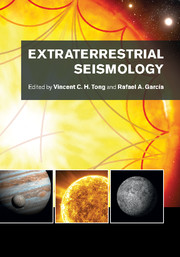Book contents
- Frontmatter
- Contents
- List of contributors
- Preface
- Acknowledgements
- List of abbreviations
- Planetary seismology: High risk, high return
- A bright outlook for helio- and asteroseismology
- Part I Observation and space missions
- Part II Data and physical parameters
- Part III Modeling approaches
- Part IV Discoveries of physical structures and processes
- 11 Asteroseismology of red giant stars
- 12 A helioseismic view of the Sun's internal structure and dynamics
- 13 Recent discoveries of structures and physical processes in local helioseismology
- 14 Seismology of giant planets
- 15 Seismicity and interior structure of the Moon
- Part V Interdisciplinary research involving planetary and astrophysical sciences
- Part VI Interdisciplinary research involving terrestrial seismology
- References
- Index
11 - Asteroseismology of red giant stars
from Part IV - Discoveries of physical structures and processes
Published online by Cambridge University Press: 05 July 2015
- Frontmatter
- Contents
- List of contributors
- Preface
- Acknowledgements
- List of abbreviations
- Planetary seismology: High risk, high return
- A bright outlook for helio- and asteroseismology
- Part I Observation and space missions
- Part II Data and physical parameters
- Part III Modeling approaches
- Part IV Discoveries of physical structures and processes
- 11 Asteroseismology of red giant stars
- 12 A helioseismic view of the Sun's internal structure and dynamics
- 13 Recent discoveries of structures and physical processes in local helioseismology
- 14 Seismology of giant planets
- 15 Seismicity and interior structure of the Moon
- Part V Interdisciplinary research involving planetary and astrophysical sciences
- Part VI Interdisciplinary research involving terrestrial seismology
- References
- Index
Summary
Introduction
If appropriately excited, a star will oscillate like a giant spherical instrument. In most stars, including the Sun, surface convection provides the excitation mechanism (Goldreich and Keeley, 1977). With turbulent velocities reaching speeds comparable to the local sound speed near the surface of the star, the vigorous convective motions can excite standing acoustic waves. These are known as pressure or p modes because the restoring force arises from the pressure gradient. The broad frequency spectrum of this excitation mechanism gives rise to many oscillation modes, both radial and non-radial, excited simultaneously. These stochastically excited and intrinsically damped oscillations were first detected in the Sun (Leighton et al., 1962), and hence are commonly known as solar-like oscillations.
Oscillation modes can be characterized by the number of nodes, n, in the radial direction, called the radial order, and a non-radial part described by spherical harmonics, each with an angular degree, l, which equals the number of nodal lines on the surface, and an azimuthal order, m, which is the number of those nodal lines crossing the equator of the star. Except for the Sun, we can generally not resolve these oscillations on the surfaces of cool stars and so the surface displacements of modes with high angular degree (l ≳ 4) cannot be observed because regions of opposite phase tend to cancel out.
When stars grow old and the supply of hydrogen fuel is exhausted in the core, their envelopes expand and cool: they become sub giants and eventually red giants. This transition is shown in the so-called HR diagram in Figure 11.1, which indicates the main stages of evolution of a one solar mass star from the “main sequence” where the Sun is currently located (between points 1 and 2) through to the red giant phase discussed in this chapter (beyond point 3).
- Type
- Chapter
- Information
- Extraterrestrial Seismology , pp. 159 - 169Publisher: Cambridge University PressPrint publication year: 2015
- 6
- Cited by



